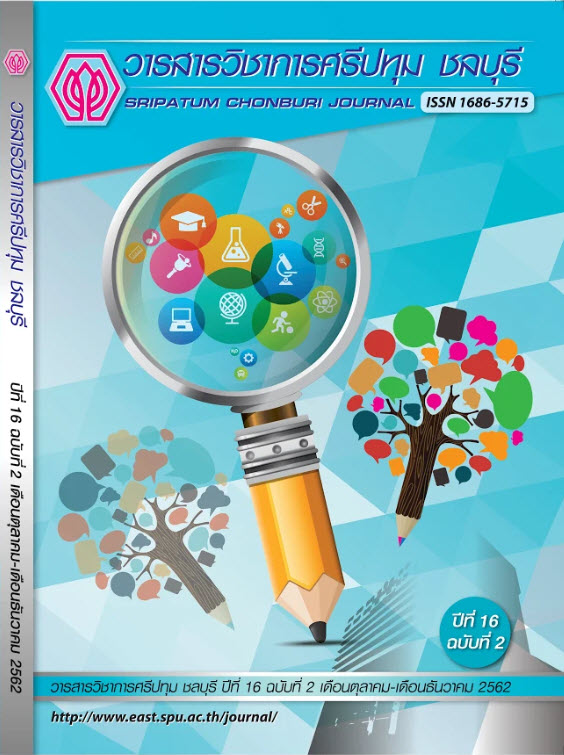THE GENERATION Y CONSUMER BEHAVIOR OF GOOD PURCHASING VIA SOCIAL MEDIA IN RAYONG PROVINCE
Keywords:
online social media, purchasing behavior, generation YAbstract
The objectives of this research were to study demographic factors affecting product purchasing and buying behaviors through social media of generation Y customers in Rayong and compare behaviors of product purchasing through social media of generation Y customers in Rayong, classified by demography factors. The sample was 400 of generation Y customers in Rayong. The data was analyzed by percentage, mean, standard deviation, t-test, Analysis of Variance (ANOVA) with statistical significance at .05 level. In cases, differences were found at a statistically significant level, the methods of Scheffé Analysis were applied.
The results indicated that most participants were female. They were students who earn an income lower than 10,000 Baht. Most popular products they buy are clothes because it was fast and convenient. The buying method was via different application. The decision time was 1 - 2 hours. The frequency was 1 time per month. The overall marketing factor that has an effect to the purchasing behavior via online social was commented in high level comment. Purchasing behavior via online social in the category of types of products depends on the personal status of gender with the significance of .05.
The results of the comparison between demographic factors and factors affecting product purchasing showed that the sample agreed with the product purchasing through online social media at a high level. The comparison of the differences of individual opinions on marketing factors affecting consumer behavior and purchasing decisions through online social media of generation Y consumers in Rayong found that there is a significant difference at the level of .05 of the overall. When comparing in terms of price, there was a significant difference at the level of .05. Distribution channels and sales promotion had no significant difference at the level of .05.
References
ณัฏฐนันท์ พิธิวัตโชติกุล. (2560). การยอมรับเทคโนโลยีโทรศัพท์มือถือ การตลาดผ่านสื่อสังคมออนไลน์และพฤติกรรมผู้บริโภคออนไลน์ที่ส่งผลต่อความตั้งใจซื้อสินค้าออนไลน์ผ่านแอปพลิเคชันของผู้บริโภคในกรุงเทพมหานคร. การค้นคว้าอิสระบริหารธุรกิจมหาบัณฑิต สาขาวิชาการตลาด, บัณฑิตวิทยาลัย มหาวิทยาลัยกรุงเทพ.
ธานินทร์ ศิลป์จารุ. (2560). การวิจัยและวิเคราะห์ข้อมูลทางสถิติด้วย SPSS และ AMOS (พิมพ์ครั้งที่ 17). นนทบุรี: เอส.อาร์.พริ้นติ้ง แมสโปรดักส์.
นันทพร เขียนดวงจันทร์, ขวัญกมล ดอนขวา และสรียา วิจิตรเสถียร. (2561). พฤติกรรมผู้บริโภคในการซื้อสินค้าผ่านสื่อสังคมออนไลน์ของคนในกลุ่มเจเนเรชันวาย. Veridian E-Journal, Silpakorn University ฉบับภาษาไทย สาขามนุษยศาสตร์ สังคมศาสตร์ และศิลปะ, 11(1), หน้า 561-577.
ยุพเรศ พิริยพลพงศ์. (2557). ปัจจัยและพฤติกรรมที่มีผลต่อการตัดสินใจใช้โมบายแอพพลิเคชั่นซื้อ
สินค้าผ่านทางสมาร์ทโฟนและแท็บเล็ตของผู้บริโภคในเขตกรุงเทพมหานคร. วิทยานิพนธ์บริหารธุรกิจมหาบัณฑิต สาขาวิชาการตลาด, บัณฑิตวิทยาลัย มหาวิทยาลัยนานาชาติแสตมฟอร์ด.
ลือรัตน์ อนุรัตน์พานิช. (2559). ทัศนคติต่อ Generation Y ของผู้เข้าร่วมอบรมเรื่อง เข้าใจ ผูกพัน รักษา จูงใจ Generation Y. Veridian E-Journal, Silpakorn University ฉบับภาษาไทย สาขามนุษยศาสตร์ สังคมศาสตร์ และศิลปะ, 8(1), หน้า 3.
สำนักงานพัฒนาธุรกรรมทางอิเล็กทรอนิกส์ (องค์การมหาชน). (2560). รายงานผลการสำรวจพฤติกรรมผู้ใช้อินเทอร์เน็ตในประเทศไทย ปี 2560. กรุงเทพฯ: สำนักงานพัฒนาธุรกรรมทางอิเล็กทรอนิกส์ (องค์การมหาชน).
สำนักงานสถิติจังหวัดระยอง (ออนไลน์). (2559). เข้าถึงได้จาก: http://Rayong.old.nso.go.th [2561, 15 มกราคม].
เสรี วงษ์มณฑา และชุษณะ เตชคณา. (2560). การตลาด 4.0 ในบริบทประเทศไทย 4.0. วารสาร
เศรษฐศาสตร์และนโยบายสาธารณะ, 8(15), หน้า 1-16.
Armstrong, G., & Kotler, P. (2013). Marketing: An Introduction (11th ed.). Upper Saddle River, NJ: Pearson.
Balakrishnan, B., et al. (2014). The impact of social media marketing medium toward purchase intention and brand loyalty among generation Y (Online). Available: https://core.ac.uk/download/pdf/82047991.pdf [2018, January 11].
Degeratu, M. A., Rangaswamy, A., & Wu, J. (2000). Consumer choice behavior in online and traditional supermarkets : The effects of brand name, price, and other search attributes. International Journal of Research in Marketing, 17, pp. 55-78.
Kim, et al. (2013). Effects of collaborative online shopping on shopping experient through social and relational perspectives. Information & Management, 50, pp. 169-180.
Kotler, P. (2003). Marketing management (11th ed.). Upper Saddle River, NJ: Pearson.
_______. (2016). Marketing 4.0: Moving from traditional to digital. Hoboken, NJ: John Wiley &
Sons.
Kotler, P., & Armstrong, G. (1999). Principle of marketing (8th ed.). Upper Saddle River, NJ: Prentice-Hall.
Richard, M. O., & Chebat, J. C. (2016). Modeling online consumer behavior: Preeminence of emotions and moderating influences of need for cognition and optimal stimulation level. Journal of Business Research, 69(2), pp. 541-553.
Salacka, D. (2017). What is marketing 4.0 (Online). Available: https://medium.com>whatsmarketing… [2018, January 11].
Downloads
Published
Issue
Section
License
บทความทุกบทความเป็นลิขสิทธิ์ของวารสารวิชาการศรีปทุม ชลบุรี



